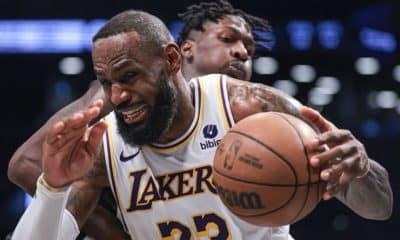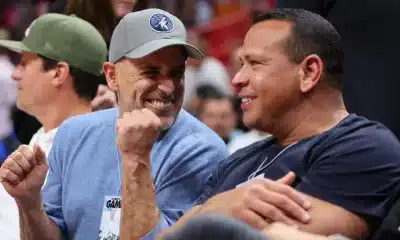NBA
NBA AM: The Garden’s Mystique
No building in the NBA is like Madison Square Garden… Because no NBA building comes close to its history.
Current NBA players refer to Madison Square Garden as the Mecca of Basketball, in part because it is the oldest standing NBA arena still in use and in part because it’s the home of New York City’s oldest professional basketball team. Still, Madison Square Garden is as much an idea as it is a building. It certainly is not only a place where basketball happens, and in a lot of ways, it means as much to New Yorkers as any other historic building in Manhattan.
The truth, though, is that the history of MSG doesn’t start with the current building at 4 Pennsylvania Plaza. There have been four of these buildings in all, dating back almost 140 years, and there has been no more fascinating structure in the history of basketball.
The story of Madison Square Garden starts, in a way, with circus mogul P.T. Barnum. In the early 1870s, a small, vacated train depot located at the corner of E. 26th Street and Madison Avenue was leased to Barnum, who converted it into an open-air oval arena with benches intended to allow circus patrons to enjoy the Greatest Show on Earth. He named it the Great Roman Hippodrome, and it served as a performance stage for his New York City circus shows for a couple of years before the lease passed onto someone else.
Eventually, the Vanderbilt who owned the property passed away, and his grandson, William Kissam Vanderbilt, took control of the property and renamed it Madison Square Garden, christened after the street named after the fourth president of the United States.
Under the new moniker, the facility hosted track and field events, bicycle races, boxing matches, the National Horse Show, and more circus events, including Barnum’s exhibition of the famous elephant Jumbo. As the first Garden inched toward dilapidation, the Vanderbilt family sold the building and the property to an ownership group that included some of the biggest names of the era, including J.P. Morgan and Andrew Carnegie.
They ripped down that original building in 1889 and constructed the second iteration of the facility in time to open in June of the following year. It cost over a half-million dollars to construct (approximately $11.7 million in today’s money) and immediately proved more profitable since it had a roof. The older building was unusable during the brutal New York winters and in the hottest heat of the summertime, but the new covered structure was cooler in summer, warmer in winter and swankier all year-round.
While there still were boxing matches in the new building, it also now hosted orchestras, operas and plays—far cries from the types of events that filled the older, dustier venue. Madison Square Garden II also was home to the first indoor football games, when a 1902 tournament hosted a number of teams, including one named, of all things, the Knickerbocker Athletic Club. Before being demolished in 1926, it even served as the location of the 1924 Democratic National Convention.
Like its predecessor, though, it also proved to be a financial failure. New York Life Insurance eventually tore it down to build a new headquarters, which of course became the New York Life Building, which remains one of the most iconic buildings in Manhattan to this day.
The third Madison Square Garden wasn’t built anywhere near Madison Square. It was built on Eighth Ave. between 49th and 50th Streets and was the first home of the New York Knickerbockers. The Basketball Association of America, one of the precursors to the NBA, actually was conceived in New York by a New York sportswriter named Max Kase, and the Knicks were among those first teams. In fact, Kase had planned on leasing the Garden and becoming the franchise’s first owner, but certain regulations required that Madison Square Garden itself own any professional teams that played their home games there.
Ned Irish, who would eventually become the team’s executive vice president, got the financial backing of Madison Square Garden’s owners to buy the team. According to Sports Illustrated, every time Kase tried to make his case on why he should be awarded the team, Irish would persistently appeal with, “three-and-a-half million.” That persistence got him a massive role in one of the league’s most storied franchises, and he helped usher them to immediate success in the Garden.
Long before the Knicks settled in, though, Madison Square Garden hosted the first ever professional basketball game in December of 1925. Over the next 40 years, the Knicks and New York Rangers would be the arena’s biggest stars, and that obviously would carry over when ground broke at the site of the Madison Square Garden that exists now.
The current location was at one time the site of the original Penn Station, but engineers left the below-ground part of the station active while building the new arena. Still, even tearing down just the above-ground portion was extremely controversial in the late 1960s, and some people were so upset that the New York City Landmarks Preservation Commission came into existence expressly to forbid any such destruction of historical architecture from happening again.
Starting in 2011, the building underwent a $1 billion series of renovations that modernized the building while preserving the historical aspects that always have made it special. Compared to the half a million dollars it cost to build the first new Madison Square Garden, it’s painfully obvious just how much more lucrative the world of professional sports has grown in the last century-and-change.
While not as old as Wrigley Field or Fenway Park, Madison Square Garden carries the same sort of historical mystique in the NBA world. There is no building more iconic in the game of basketball, so while the current iteration isn’t all that old in the grand scheme of things, its overall history is as rich as any building in sports.
What started as an open-air dirt amphitheater for the circus has since become the quintessential indoor sports and concert venue in the United States.
If only P.T. Barnum could see it now.
Add Basketball Insiders to your Google News Feed!
-
Main Page 1 week ago
LeBron James joins Michael Jordan as only NBA players with multiple 40-point games after turning 39
-
Main Page 1 week ago
Nikola Jokic 1st NBA player since Oscar Robertson with 26+ points, 18+ rebounds, & 16+ assists in a game
-
NBA 1 week ago
Ex-MLB star Alex Rodriguez vows to keep trying to buy Timberwolves franchise despite rejection
-
Main Page 1 week ago
Kings are 14-5 this season when Keegan Murray scores 19+ points







